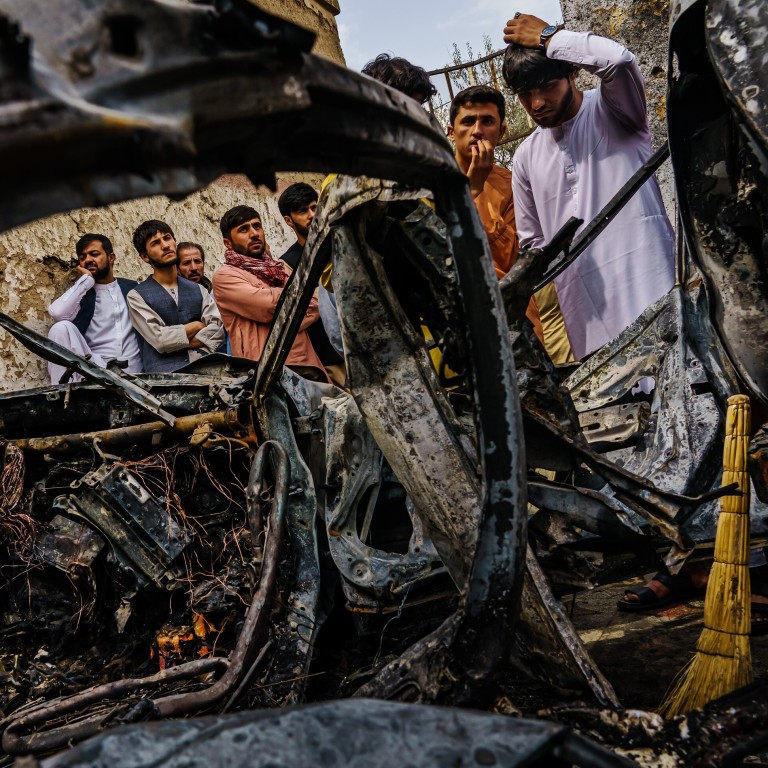
Kabul drone strike exposes myth of Joe Biden’s ‘over the horizon’ war on terror
- The death of 10 Afghan civilians in what the US military termed ‘a tragic mistake’ is a reminder of the problems in relying on drone warfare
- Not only are drones fallible, but the invulnerability of their operators increases the propensity for unchecked aggression
But 20 years on, a reminder that “precision strikes” can be anything but has come from Kabul.
While it acknowledged that some were innocent, the US military initially insisted it was a “righteous strike” that prevented another suicide attack.
An investigation launched by American media proved the Pentagon wrong barely three weeks later. On September 17, the military reversed course, and apologised for what it called a “tragic mistake” which took the lives of innocents, including children.
The incident was a shocking reminder of the dangers that surround the use of drones, and should prompt lawmakers and other government officials to take a closer look at the procedures that govern such strikes.

02:52
US retaliates for Kabul airport attack with drone strikes on Afghan capital and border region
Several myths surrounding drone use will need to be dispelled in such an effort. The first involves their name itself: “Unnamed Aerial Vehicles.” This is a misnomer. The US military is adamant about the fact that there is always a human in the kill chain process. This is problematic, as humans are fallible. A drone pilot, usually located far from the battlefield in an air-conditioned container on the other side of the world, is not immune to bad judgment.
Moreover, killing other humans from a distance is no less traumatic than doing so up close, and many drone pilots have reported suffering from Post-Traumatic Stress Disorder (PTSD).
Good intelligence is key to a successful drone strike, but this is often hard to get. Finally, the decision to fire has to be taken quickly, and political pressure to get results – or avoid accidents – adds to combat stress. Taken together, they add up to what the Prussian general Carl von Clausewitz termed the “fog of war”.
The second myth is related to the first. “Unmanned” also means drone operators are invulnerable. The perception of being able to strike without being killed or injured not only lowers the threshold to risk acceptance, but also increases the propensity for unchecked aggression.
The 44-day war over Nagorno-Karabakh provided ample evidence of this. Bolstered by their use of drones, Azerbaijani troops massed forward, only to be cut down by Armenian gunfire. The Armenians, initially cowed by the use of so-called “loitering munitions” – flying suicide bombs – threw more manpower into the fight.
The result: brutal, World War I-style trench warfare, which left piles of bodies putrefying for weeks in no man’s land. It was as far from a “sanitary” war as could be.
He was, of course, referring primarily to drones. The promise of being able to win a war by employing only air assets or precision missiles is as old as the first biplane.

Air superiority is a fundamental component of both modern warfare and deterrence. However, the illusion that boots on the ground are useless is not only misleading, but terribly dangerous. During two decades of warfare in Afghanistan, a high percentage of US-led drone strikes caused considerable collateral damage, an aseptic term for innocent, dead civilians.
There were a number of factors that caused this: faulty intelligence, locals settling old scores in tribal feuds by accusing their enemies of being militants, or just being in the wrong place at the wrong time. In response, the US developed a missile that releases six blades to kill targets without exposing others nearby to a conventional missile’s blast radius.
The AIM-114R9X Hellfire seems like a good idea. But all the complex algorithms, social media scans, phone tracking and geo-tagging in the world will just lead you to an educated guess. The chance that someone is in the wrong place at the wrong time is still high.
Without troops in Afghanistan, the question of how the US will succeed in this “over the horizon” war on terror is a valid one. Without intelligence assets on the ground, targeting will be even more of an exercise in guesswork. Or, speaking of myths, perhaps US Central Command is expecting the Taliban to provide information on its – supposed – enemy, Isis-Khorasan.
The tragic strike in Kabul on August 26 will not be the last mistake of the drone era. Better intelligence, as well as better scrutiny at all levels of government and clearer rules of engagement are sorely needed to prevent future mistakes. More importantly, the deaths of 10 innocents should lay to rest the biggest myth of all: that “precision” drone strikes are a cost-free way to wage war.
Dr Alessandro Arduino is principal research fellow at the Middle East Institute at the National University of Singapore

